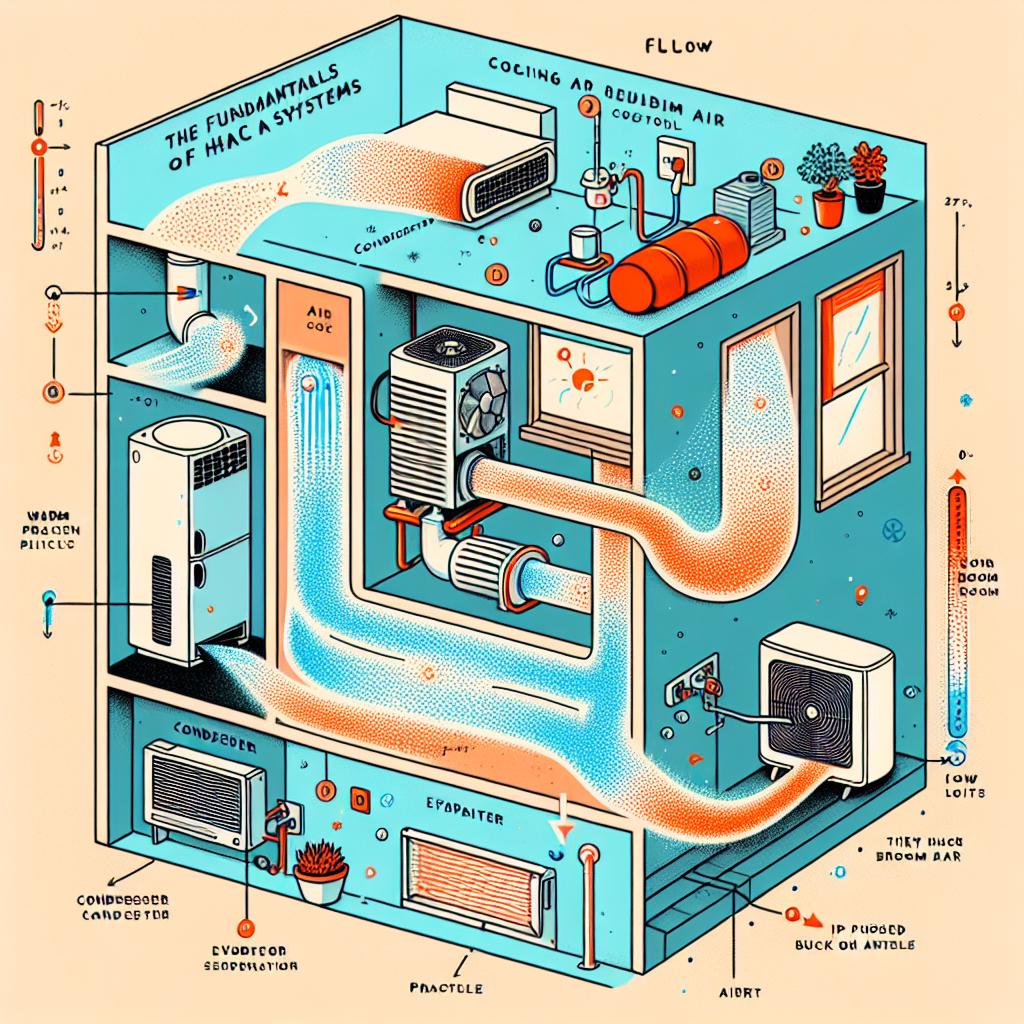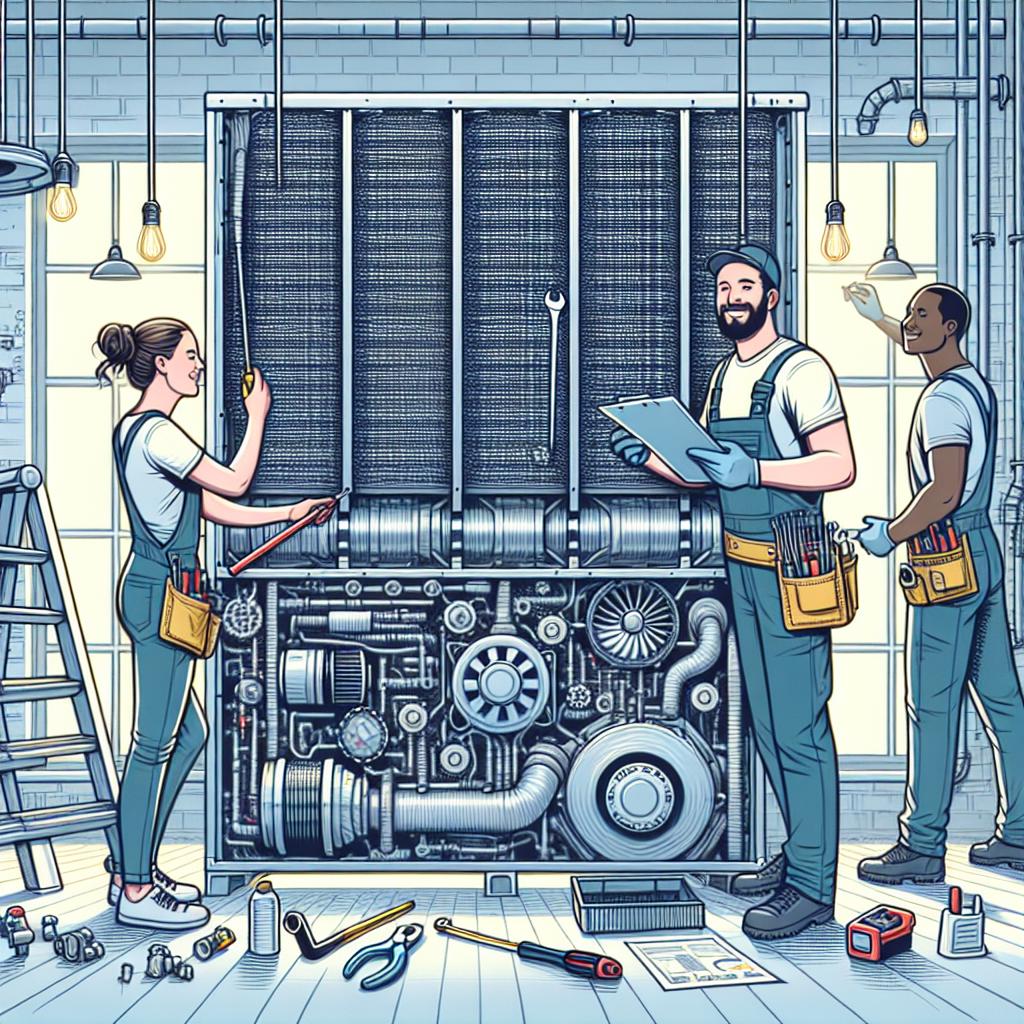In the intricate dance of comfort that defines our indoor spaces, the unseen hero is often the HVAC system, tirelessly working to maintain the perfect balance of temperature and freshness. However, even the most sophisticated systems can sometimes fall short, leading to stuffy rooms and uneven temperatures. If you’ve ever found yourself fanning a magazine or cracking open a window in the midst of summer’s heat, you know the frustration of inadequate airflow all too well. But fear not! Unlocking optimal airflow in your HVAC system doesn’t involve a complete overhaul or a hefty investment. Instead, with a few strategic tweaks and mindful practices, you can breathe new life into your environment. In this article, we’ll explore practical and effective ways to increase airflow in your HVAC system, ensuring that every corner of your home feels as refreshing as a gentle breeze on a warm day.
Understanding the Fundamentals of Airflow in HVAC Systems
Airflow is a crucial element in HVAC systems, impacting not only comfort but also efficiency and air quality. To boost airflow, one should consider several essential components that contribute to overall system performance. Ductwork design plays a significant role; ensure that ducts are properly sized and efficiently routed. This includes avoiding sharp bends and ensuring there are no obstructions within the ductwork. Regular maintenance is equally important—clean filters, inspect fans, and check for leaks to ensure that air is flowing efficiently throughout the system.
Another effective way to enhance airflow is by optimizing system balance. Balancing involves adjusting dampers to control the flow of air to different areas of a building. This will help in achieving an even distribution of air, eliminating hotspots or areas that remain cold. Additionally, consider the placement and condition of vents and registers; they should remain unobstructed and be cleaned regularly to maintain optimal performance. By focusing on these fundamentals, homeowners can significantly enhance airflow in their HVAC systems, leading to improved efficiency and comfort.

Identifying Common Airflow Problems and Their Solutions
Many homeowners may encounter several obstacles that can impede the efficiency of their HVAC systems, resulting in poor airflow. Blocked vents and ducts are among the most common problems, often caused by furniture placement, dust build-up, or even structural issues within the home. To resolve this issue, a thorough inspection of all air vents and ducts is crucial. Cleaning or relocating obstructions can significantly improve air circulation. Dirty air filters also play a pivotal role in restricting airflow. Regularly replacing or cleaning air filters ensures that your system operates smoothly, allowing optimal air distribution throughout your space.
Another significant factor is the size of the HVAC system, which may not be appropriate for the space it serves. An oversized or undersized unit can compromise airflow and lead to inefficiencies. If your HVAC system consistently cycles on and off, it might be time to consult a professional for an assessment. Additionally, leaks in ductwork can cause air to escape before reaching its intended destination. Sealing these leaks with appropriate materials, such as duct tape or mastic, can improve overall airflow effectiveness. Below is a simple table outlining these common problems and their respective solutions:
| Airflow Problem | Solution |
|---|---|
| Blocked vents or ducts | Inspect and clear obstructions |
| Dirty air filters | Replace or clean regularly |
| Incorrect HVAC size | Consult a professional for assessment |
| Duct leaks | Seal leaks with duct tape or mastic |

Optimizing Duct Design for Enhanced Air Distribution
Effective air distribution relies heavily on the design and configuration of your ductwork. To achieve optimal airflow, it is essential to consider several factors during the planning phase. Duct size plays a pivotal role; using oversized ducts can lead to reduced air velocity, while undersized ducts may cause excessive friction and restrict flow. Additionally, improperly placed duct fittings can create turbulence, disrupting smooth airflow. Here are a few strategies to enhance duct design:
- Utilize curved fittings instead of sharp bends to minimize resistance.
- Ensure straight runs as much as possible to promote unimpeded airflow.
- Isolate ducts from heat sources to prevent thermal losses.
The layout of your duct system also greatly influences performance. Analyze the placement of vents and returns to ensure balanced air distribution throughout the space. A common pitfall is having too many vents in a single area, leading to uneven cooling and heating. Implementing proper zone control systems can provide tailored comfort by adjusting airflow based on specific room needs. Consider this simple table for assessing duct layout effectiveness:
| Element | Optimal Choice | Pitfall |
|---|---|---|
| Duct Size | Calculate based on airflow requirements | Fixed sizes without consideration of system demand |
| Fitting Type | Use bends over elbows | Sharp bends causing turbulence |
| Vent Placement | Distribute evenly across the space | Concentrating too many vents in one area |

Implementing Routine Maintenance for Sustained Airflow Efficiency
To ensure your HVAC system operates at peak efficiency, routine maintenance is crucial. Start with a plan that includes regular checking and replacing of air filters, as dirty filters can significantly restrict airflow. Schedule seasonal inspections where professionals can clean ducts, check for any air leaks, and ensure that components like the blower motor and coils are functioning correctly. Regular maintenance not only enhances airflow but also extends the lifespan of your system, preventing costly repairs down the line.
In addition, consider implementing a checklist for your maintenance routine to keep track of essential tasks. This could include:
- Checking and cleaning air vents to ensure no obstructions.
- Testing thermostat accuracy to ensure proper temperature control.
- Inspecting insulation around ductwork to minimize energy loss.
- Lubricating moving parts to reduce wear and tear.
By prioritizing these maintenance tasks, you can considerably improve your HVAC system’s airflow and energy efficiency.
Q&A
Q&A: How to Increase Airflow in HVAC Systems
Q1: Why is good airflow important in an HVAC system?
A: Good airflow is critical for maintaining comfort and efficiency in heating, ventilation, and air conditioning systems. It ensures even temperature distribution, prevents system overload, enhances indoor air quality, and ultimately reduces energy costs. Without adequate airflow, rooms may become hot or cold, leading to an uncomfortable environment.
Q2: What are some common signs of poor airflow in an HVAC system?
A: If you notice temperature inconsistencies between rooms, excessive noise from the system, increased energy bills, or airflow that feels weak or restricted at vents, these can be indicators of poor airflow. Additionally, frequent system cycling or the presence of stale or musty odors may also signal airflow issues.
Q3: How can I assess the airflow in my HVAC system?
A: To assess airflow, start by checking the temperature differential between supply vents and return vents. You can use a digital thermometer or an analog one to measure the air coming out of the vents. A noticeable difference can indicate healthy airflow. Consider hiring a professional for a detailed diagnostic, especially if the problem persists.
Q4: What steps can I take to improve airflow in my HVAC system?
A: There are several strategies you can implement:
- Change Air Filters Regularly: Clogged filters restrict airflow. Swap them out monthly or seasonally, depending on usage and environmental factors.
- Clean and Inspect Ductwork: Dust, debris, or even mold buildup in ducts can obstruct airflow. Periodically inspect and, if necessary, clean your ductwork to ensure optimal performance.
- Check Vents and Register Locations: Make sure that vents are not blocked by furniture, curtains, or other obstacles. Ensure they are fully open to facilitate unrestricted airflow.
- Adjust Dampers: If your system uses dampers, adjust them to balance airflow among different areas of your home.
- Use Fans Strategically: Ceiling fans can help circulate air more evenly throughout rooms, enhancing the effectiveness of your HVAC system.
Q5: Is it worth investing in a professional evaluation?
A: Yes, investing in a professional evaluation can be a game-changer, especially if you’ve tried DIY methods without success. HVAC technicians have the tools and expertise to identify complex issues, perform airflow tests, and recommend efficient solutions, saving you time and potentially high-energy costs in the long run.
Q6: Can upgrading my HVAC system lead to better airflow?
A: Absolutely! Older systems may struggle with airflow due to outdated technology or insufficient capacity for your home’s needs. Upgrading to an energy-efficient model can boost airflow, improve overall comfort, and reduce energy consumption. Be sure to consult a professional to determine the right size and type of system for your space.
Q7: Are there any maintenance practices I should follow to sustain good airflow long-term?
A: Regular maintenance is key! Schedule professional inspections at least once a year, keep your outdoor unit clear of debris, and monitor humidity levels in your home. Regularly check and clean air filters and ductwork to ensure optimal performance. Staying proactive can lead to sustained efficiency and comfort year-round.
By following these guidelines, you can enhance airflow in your HVAC system, ensuring a more comfortable and energy-efficient living environment.
Concluding Remarks
enhancing airflow in your HVAC system is not only a step toward improved comfort in your home but also a vital stride towards energy efficiency. By implementing the strategies discussed—from optimizing ductwork and investing in quality filters to regular maintenance and mindful usage—you can transform your living space into a haven of fresh, circulating air. Remember, a well-functioning system not only reduces energy costs but also promotes a healthier indoor environment. As you embark on this journey towards better airflow, keep in mind the importance of a proactive approach to maintenance and adaptability in your methods. Here’s to a breath of fresh air in every corner of your home!

